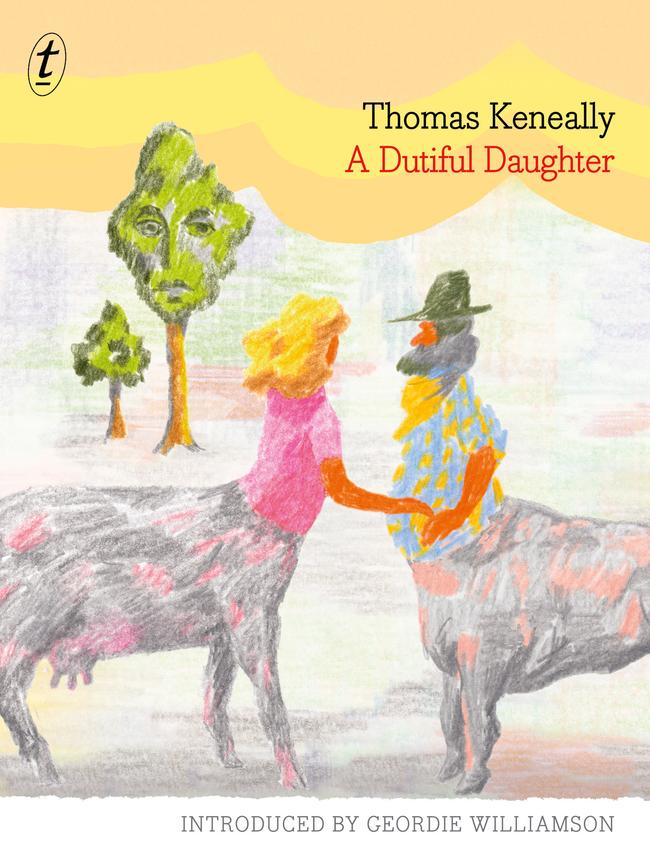Home truths
Thomas Keneally’s favourite is a novel for the ages.

‘The style of a narrative is a kind of dialect,” observed American writer and painter Guy Davenport in a 1976 essay. “The laws it obeys are of its own nature.”
These words appeared five years after publication of the novel that occupies the extreme orbit of Thomas Keneally’s imaginative universe. A Dutiful Daughter is at once the most introvert and urgently expressive of his works: a northern hemisphere allegory set on a swamp-ridden dairy farm somewhere on the coastal fringe of the “least significant of continents”, a tale of incest and bestial transformation that plays out somewhere between kitchen-sink realism and philosophical novel.
If A Dutiful Daughter lacks the savagery that marks The Chant of Jimmie Blacksmith from 1972, it nonetheless has a core every bit as shadowy and aggrieved. And where that later and more famous fiction could clearly be situated within its larger political and social context, Keneally’s own favourite among his works uses fabulist elements to deflect more obvious links between word and world.

The novel transmits a message — one embedded in some of the most visceral, anguished and elegant prose Keneally has produced — that is not easily discerned.
Davenport’s observation can be taken further in the case of A Dutiful Daughter. This is a narrative with its own idiolect, a private language of sign or symbol that at first seems to refer exclusively to itself. Only gradually does it release hints of broader meaning, and these are all the more disturbing and momentous for being treated so.
Take the novel’s scant opening chapter, barely two full pages, which begins:
It had been a thunderous spring. On Saturday, thunder again rolled over the Glover farm. Perhaps, even with four hundred of its acres swamped, it was not yet convinced of the powers of water. At the peak of her thirty best and merely sodden acres, Barbara Glover, in her kitchen, was taken by a sudden fury at the crisp network voice that said “further thundery showers”. She dropped the half- drawn syringe of antibiotic and ground the radio knob to off, as if the broadcaster were vulnerable at her hands.
So much is said here; so much of importance is communicated through language as semantically concrete as it is referentially vague — from the literal fact of the meteorological phenomenon that threatens to shut the isolated, inundated farm off from the world, to the symbolic severance by Barbara of the frail media thread that attaches her to distant modernity, to the studied stylistic repetition of “thunder” and its variants that seems to echo the auditory action of a gathering storm.
The total effect is of a snowdome lid descending over the scene, sealing it off completely. It could also be registered as biblical, such a deluge. This is not a novel where God is present, however, except by human registration of her absence.
But why the doubled insistence on Barbara Glover’s ownership of both land and hearth? And what about that syringe, dropped like Chekhov’s revolver? The second half of this passage doesn’t provide much respite from the general mystification:
Rain, she could see, was falling on the rim of the mountains down which her brother was coming home. Or was supposed to come home — yesterday. Barbara breathed and drew herself up to quash her sick anger at his culpable non-arrival, the sick longing for his coming.
We infer that Barbara Glover has a primary, unmediated understanding of her world and its workings, one that requires no official bolstering. We also gather that her brother inspires an ambivalence so strong that it manifests as nausea.
Damian (a name derived from the Greek word domazo, meaning to conquer or tame) is getting a lift over the sodden hill as his sister drops the syringe. He is the younger sibling, soft and pliant in contrast to Barbara’s steely vehemence. Escaped to the regional centre and university, he has spent the night in the nearest town with Helen, a fellow student and his lover, rather than coming straight home.
He is torn, we learn, emotionally and intellectually, between the blandishments of the outside world and the closed familial circuit of the farm: between the ordinary prospects of intimacy and marriage and normalcy implicit in Helen’s affection, and those deeper currents that link him to Barbara.
The novel belongs to Damian in one sense, since it is told through him using the rarely employed second-person perspective. The continuous use of “You” in reference to Damian’s interior struggles is oddly fascinating: it creates a mirror effect. It’s as if the author is admonishing himself via his creation. Either that, or Keneally is drawing readers into an uncomfortable proximity with Damian’s guilt and confusion.
But the narrative as a whole bends in tribute towards the beautiful sister left behind in her rural fastness. She is the dominant agent here, and nowhere more so than in relation to Barbara and Damian’s parents: a couple we are first introduced to as invalids requiring constant care and attention, but soon come to know as something far stranger.
Keneally’s novel begins in a way that suggests the objective eye of the author trained on a reliable, prosaic reality. The sense of moment is keenly painted. It is the late 1960s; a decade of ferment and upheaval elsewhere in the world is dawning now, even on what is probably the mid-north coast of NSW.
It is hard not to read the assertiveness of female voice in this novel, its concentration on the uneasy coexistence of old patriarchal certitudes alongside new liberatory thought, without thinking of Germaine Greer’s The Female Eunuch, published the year before A Dutiful Daughter, with its wild rhetoric and defiantly pornographic vocabulary.
The author is similarly alert to the nature of people and place. The hardscrabble rural life, the insularity of families clinging to the lower rungs of a fraying economic order: these are familiar to anyone who grew up in country Australia in those years. Yet the language with which Keneally describes this world remains luminous and exact. Even dull poverty shines under his ministrations.
All this accumulated world data, this lustrous attentiveness, comes up hard against the sheer irreality of the truth. The Glover parents aren’t invalids; they are bovine centaurs: half human, half cattle. This transformation occurred years before, when Barbara first menstruated, a time to which the narrative circles back to describe.
The 12-year-old Barbara has no sense of the reason for her bleeding. She believes that she is dying and spends a night in mortal fear. Only in the morning, when she commands her little brother to burn her soiled nightgown and Damian is caught in the act by their parents, is the ordinariness of her situation admitted to.
Barbara has become a woman without her mother and father ever apprising her of the conditions of entry to that state. This new knowledge — of both biology and parental betrayal — is empowering in a terrible way. Having run away with her parents in pursuit, she returns to the farm and an astonished Damian hours later, leading her newly altered folks like chastened livestock behind her.
At which point, every reader of this remarkable book will ask: what does it all mean?
In John Updike’s The Centaur, a partly autobiographical novel from 1963, the narrator’s father is viewed on occasion as a centaur (indeed, he is Chiron, first and best of his kind) as a way of describing the disjunction between the modest life of a Pennsylvania high school teacher and that individual’s grander aspirations, his elevated soul-station. Updike uses mythic shifts to ennoble an ordinary man.
This is not Keneally’s approach. Rather, he releases some animalistic impulse latent in the old farming couple: one a returned wartime corporal, the other a strict Catholic termagant. Are they representative of an ossified demographic, destined to be swept aside by the young? Or are they vessels of Christian suffering, admonished by the very Earth they presumed to flourish upon?
In any event, the cruelties they undergo and inflict are shocking, candid, and not to be erased from the mind’s eye.
Granted full charge of the household from that early age, Barbara keeps up a wall of bureaucratic pretence that her parents are still whole and extant.
She rules them, but she is trapped by them; she seals herself up in virginity and becomes obsessed by a manuscript of a medieval trial that has come into her possession, one that may well be a lost transcript of the legal examination of Joan of Arc.
If this sounds like curious reading material for a half-educated country girl, recall the peasant ground from which the legendary French warrior-mystic emerged.
Damian’s freedom, then, is premised on his sister’s seclusion, her imprisonment. It is a heavy price, and one he loves her for paying: so much so that the pair, at one dangerous, vivid point, become lovers. Damian’s latest return to the farm throws into stark relief the choices facing them both. When Helen turns up to claim her boyfriend, while another suitor finally breaks through Barbara’s imperious self-containment, the stage is set for a backblocks cataclysm.
Such is the weirdness of this material, it would have fallen to pieces in a lesser author’s hands. Keneally, writing at the white heat of his early and more enamelled style, resolves the issue by framing it all in terse, tidy, concise language, often uncommonly beautiful, that seems to say: believe me or not — I don’t care.
The indifference, allied to the intensity of expression his creations parade, works through the logic of paradox. As a former seminarian, Keneally had Christian theology at his fingertips during the novel’s creation. He understood the enduring power of paradox in the Christian tradition: the Trinity, the Incarnation, Christ’s hypostatic union of earthly boundedness and godlike infallibility.
These are puzzles, like the disagreements between the four Gospels, that we are still, millennia later, venturing to resolve.
A Dutiful Daughter might be described as a novel built from secular paradoxes. It proceeds as social realism yet is shaped by the utmost fabulism; it raids a Western European myth kitty but its setting is antipodean.
The novel swaddles its vision of ugliness, despair, wounded sexuality, filicide, madness and disease in burnished prose. It proceeds, with careful objectivity, to describe a situation of psychological extremity. Finally, A Dutiful Daughter gestures furiously towards the world as it is — the radical politics, the emerging neoliberal moment, the decline and fall of a certain kind of Australian existence, the blowing-up of the last balustraded remnants of sexual Victorianism — while refusing to allow its perfect narrative sphere to be violated by that world’s dull contingencies.
“Narrative voice,” writes Davenport in the same essay — by which he means that mysterious amalgam of “tone, attitude, confidence” by which a work of literature lives and breathes — “is as characteristic of its epoch as any other style”. In refusing to submit A Dutiful Daughter fully to time and place, Keneally kept his narrative mysterious, inviolable. This is no period piece; it is a small, strange, darkling classic, composed for the private eternity of a proper artist.
Geordie Williamson is The Australian’s chief literary critic. This is his introduction to the Text Classics edition of Thomas Keneally’s A Dutiful Daughter, published next week (208pp, $12.95).
Thomas Keneally will be at the Sydney Writers Festival, April 29-May 5. www.swf.org.au




To join the conversation, please log in. Don't have an account? Register
Join the conversation, you are commenting as Logout